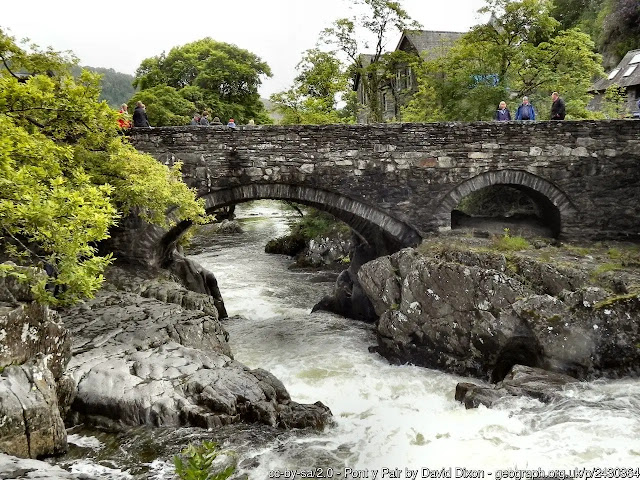 |
| The Gwydyr Forest Park |
Neolithic people lived in the mountainous
regions of the area until around 600 B.C. when the Celt people moved
there. The location is where a Celtic Christian community founded a
monastry
in the late 6th century CE. Stone Age man also lived in the area and
was
responsible for the 5,000 year old Neolithic Burial Chamber at Capel
Garmon, a celebrated cromlech and there are also spectacular views of
the
mountains of Snowdonia from here. Pont-y-Pair (the bridge of the
cauldron), built-in 1468 is the oldest existing bridge in the centre of
the village and is buffeted by foaming water after heavy rain. A number
of sign-posted walks in the surrounding countryside start near this
bridge. A mile or so away is the Miner’s Bridge, on the road to Capel
Curig, where the miners crossed the river on a steep ladder to their
work. Thomas Telford's iron Waterloo Bridge built in 1815, which carries
the A5 across the River Conwy, bears the cast iron inscription, 'This
arch was constructed in the same year the battle of Waterloo was
fought.' It was opened to carry the Irish Mail road across the River
Conwy and through the village. The establishment of the route brought an
economic boost to the area as the village became a major coach stop
between Corwen and Capel Curig and also led to improvement of the roads
to Blaenau Ffestiniog and to Llanrwst and Conwy. In 1844 English landscape painter David Cox established what would become known as the Betws-y-coed artists' colony, the first group of its kind in Britain.
 |
| The Waterloo Bridge |
The Sappers Suspension Bridge across the River Conwy near St. Michael’s Church dates from 1930 and replaced an earlier bridge from 1917 built as an alternative for The Stepping Stones which can still be seen from the golf course. Also worth visiting are the awesome Conwy Falls off the road to Pentrefoelas and the beautiful Fairy Glen off the A470 where the River Conwy flows through a narrow gorge. The opening of roads and railways attracted vast numbers of visitors to the area, particularly artists, poets and writers who were drawn to the clean air and wonderful scenery and as a result, Betws-y-Coed became home to Britain's first artists' colony. During this Victorian era, the village grew as a tourist destination and accommodation flourished. Hotels arranged excursions via their own horse-drawn transport and in the 1930s dedicated excursion steam trains took factory workers from Lancashire into Betws–y-Coed for a day out. The Trefriw Spa was opened to the general public and became popular with visitors in its own right. Paddle steamers docked at the Trefriw quay side until the outbreak of the 2nd World War in 1939.
see also :- http://www.thefootballvoice.com/2022/06/lets-have-day-out-to-southport.html

No comments:
Post a Comment